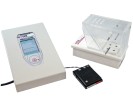Authors
Suto T, Kato D, Koibuchi I, Arai Y, Ohta J, Hiroki T, Obata H, Saito S.
Lab
Gunma University Graduate School of MedicineGunma, Japan.
Journal
Sci Rep.
Abstract
Chronic pain and attention-deficit hyperactivity disorder (ADHD) frequently coexist. However, the common pathology is still unclear. Attenuated noradrenergic endogenous analgesia can produce acute pain chronification, and dysfunction of noradrenergic systems in the nervous system is relevant to ADHD symptoms. Noxious stimuli-induced analgesia (NSIA) is measured to estimate noradrenergic endogenous analgesia in spontaneously hypertensive rats (SHR) as an ADHD model and control. Recovery of pain-related behaviors after paw incision was assessed. Contributions of noradrenergic systems were examined by in vivo microdialysis and immunohistochemistry. The SHR showed attenuated NSIA and needed a more extended period for recovery from acute pain. These results suggest ADHD patients exhibit acute pain chronification due to pre-existing attenuated noradrenergic endogenous analgesia. Immunohistochemistry suggests abnormal noradrenaline turnover and downregulation of the target receptor (alpha2a adrenoceptor). Standard ADHD treatment with atomoxetine restored NSIA and shortened the duration of hypersensitivity after the surgery in the SHR. NSIA protocol activated the locus coeruleus, the origin of spinal noradrenaline, of both strains, but only the control exhibited an increase in spinal noradrenaline. This result suggests dysfunction in the noradrenaline-releasing process and can be recognized as a novel mechanism of attenuation of noradrenergic endogenous analgesia.
BIOSEB Instruments Used:
Static Weight Bearing Touch: Incapacitance Test (BIO-SWB-TOUCH-M)

 Pain - Thermal Allodynia / Hyperalgesia
Pain - Thermal Allodynia / Hyperalgesia Pain - Spontaneous Pain - Postural Deficit
Pain - Spontaneous Pain - Postural Deficit Pain - Mechanical Allodynia / Hyperalgesia
Pain - Mechanical Allodynia / Hyperalgesia Learning/Memory - Attention - Addiction
Learning/Memory - Attention - Addiction Physiology & Respiratory Research
Physiology & Respiratory Research
 Pain
Pain Central Nervous System (CNS)
Central Nervous System (CNS) Neurodegeneration
Neurodegeneration Sensory system
Sensory system Motor control
Motor control Mood Disorders
Mood Disorders Other disorders
Other disorders Muscular system
Muscular system Joints
Joints Metabolism
Metabolism Cross-disciplinary subjects
Cross-disciplinary subjects Preclinical studies and opioids: role in crisis management in the United States
Preclinical studies and opioids: role in crisis management in the United States 